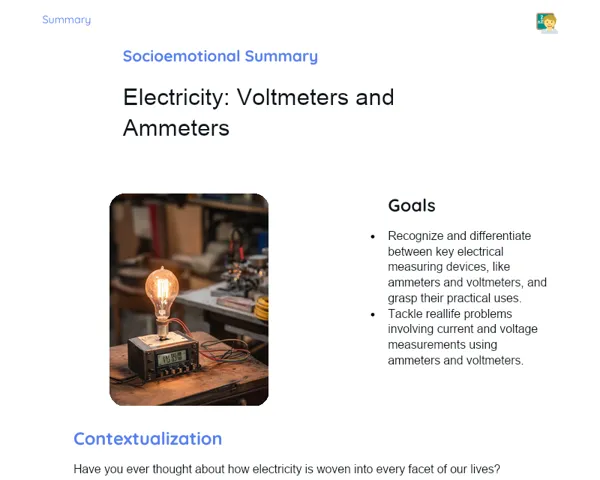Summary Tradisional | Thermodynamics: Average Speed of Gas Molecules
Contextualization
Thermodynamics is an important branch of physics that examines the interactions between heat, work, and energy. One of the key concepts within thermodynamics is the average speed of gas molecules. This concept aids in understanding how heat and temperature impact particle movement in gases. Molecules in a gas are always on the move, and the average speed of these molecules serves as a statistical metric giving us insights into the general behaviour of gas.
In the context of gases, the average speed of molecules is closely linked to temperature. As temperature goes up, the molecules acquire more kinetic energy, leading to an increase in their average speed. This understanding is vital for explaining phenomena such as gas pressure and volume, which are influenced by molecular movement. For instance, at room temperature, oxygen molecules in the atmosphere travel at an average speed of around 500 m/s, illustrating the swift motion of gas particles around us, even if they aren't visible.
To Remember!
Definition of Average Speed of Gas Molecules
The average speed of gas molecules is a statistical measure that reflects the typical speed of particles within a gas sample. While individual molecules can have varying speeds, the mean provides valuable insight into the overall behaviour of the gas. Understanding this measure is fundamental to knowing how molecules behave in different conditions, such as with varying temperature and pressure.
Additionally, the average speed is affected by the mass of the molecules as well as the temperature of the gas. Lighter molecules tend to move more rapidly than heavier ones at the same temperature. This concept is essential for grasping the speed distribution in a collection of gas molecules, which follows a statistical pattern known as the Maxwell-Boltzmann distribution.
The average speed of molecules also helps elucidate macroscopic phenomena like gas pressure. When molecules collide with the walls of their container, they apply a force that, when spread over the surface area, results in gas pressure. Thus, the average speed of molecules is crucially tied to the pressure exerted by the gas in a closed environment.
-
The average speed of molecules is a representative statistical measure.
-
Lighter molecules typically exhibit a higher average speed.
-
The average speed of molecules is linked to gas pressure.
Relationship Between Temperature and Average Speed
The temperature of a gas has a direct correlation with the average kinetic energy of its molecules. Generally, as the temperature rises, the average kinetic energy of the molecules also increases, causing them to move faster. This relationship is foundational in thermodynamics, as it highlights the connection between thermal energy and molecular movement.
The equation connecting temperature to average kinetic energy is expressed as: E_cin = 3/2 kT, where E_cin represents average kinetic energy, k is the Boltzmann constant, and T denotes the temperature in Kelvin. This relationship shows that average kinetic energy is proportional to the absolute temperature of the gas. Therefore, a rise in temperature results in an increase in molecular speed.
This principle carries significant practical implications. For instance, in an internal combustion engine, when the fuel-air mixture is compressed and heated, it leads to an increase in the average speed of the molecules and, consequently, the pressure exerted by the gas. This high pressure is vital for the functioning of the engine, as it is used to perform mechanical work.
-
Temperature correlates directly with average kinetic energy.
-
The equation E_cin = 3/2 kT connects kinetic energy and temperature.
-
An increase in temperature leads to a rise in average molecular speed.
Formula for Average Speed
The formula to determine the average speed of gas molecules is given by v = √(3kT/m), where v represents the average speed, k is the Boltzmann constant, T is the temperature in Kelvin, and m is the mass of the molecule. This formula arises from the kinetic theory of gases and offers a practical means to calculate average speed based on measurable parameters.
Each element of the formula holds significant meaning. The Boltzmann constant (k) acts as a physical constant relating energy to temperature. Temperature (T) must be expressed in Kelvin to align with the Boltzmann constant. The mass (m) denotes the mass of a single gas molecule, typically measured in kilograms. The square root signifies that average speed increases with the square root of temperature while decreasing in relation to the square root of molecular mass.
This formula proves useful for addressing practical challenges in physics and engineering. For example, by calculating the average speed under varying temperatures, we can anticipate how a gas will act in confined spaces, like pressurized containers or engines. This understanding is crucial for the safe design and operation of equipment utilizing gases.
-
The formula is v = √(3kT/m).
-
Boltzmann constant (k) relates energy and temperature.
-
Average speed increases with temperature and decreases with molecular mass.
Impact of Molecular Speed on Gas Behavior
The average speed of gas molecules profoundly influences the macroscopic properties of the gas, like pressure and volume. Boyle's Law and Charles's Law are essential for understanding these connections. According to Boyle's Law, for a gas at constant temperature, the product of pressure and volume remains unchanged. Therefore, if the average speed of molecules escalates due to rising temperature, pressure will also rise if the volume is held constant.
Charles's Law indicates that, for a gas at constant pressure, the volume is directly proportional to the temperature. Hence, when temperature rises, leading to an uptick in average molecular speed, the volume of the gas will expand if the pressure is constant. These laws illustrate how average molecular speed can directly affect observable gas properties.
Moreover, in practical contexts like hot air balloons, understanding the average speed of molecules is critical. Heating the air inside the balloon causes the molecules to move more quickly, raising the pressure and allowing the balloon to expand. This principle is at the heart of various technologies and industrial processes involving gases.
-
The average speed of molecules influences the pressure and volume of the gas.
-
Boyle's Law: pressure and volume are inversely related at constant temperature.
-
Charles's Law: volume is directly proportional to temperature at constant pressure.
Key Terms
-
Average Speed of Molecules: a statistical measure that represents the average speed of particles in a gas sample.
-
Temperature: a measure of the average kinetic energy of gas molecules.
-
Boltzmann Constant: a physical constant that connects thermal energy to temperature.
-
Boyle's Law: describes the inverse relationship between the pressure and volume of a gas at constant temperature.
-
Charles's Law: describes the direct relationship between the volume and temperature of a gas at constant pressure.
-
Kinetic Energy: the energy that a molecule possesses due to its motion.
Important Conclusions
In today's lesson, we covered the crucial topic of the average speed of gas molecules, emphasizing its significance for understanding gas behaviour under varying conditions. We observed that average molecular speed is directly linked to gas temperature, increasing with rising temperature. We employed the formula v = √(3kT/m) to calculate this average speed, where k is the Boltzmann constant, T is the temperature in Kelvin, and m is the mass of the molecule.
We also explored how molecular speed affects the macroscopic properties of gases, including pressure and volume, as governed by Boyle's and Charles's Laws. This knowledge has widespread practical applications, from internal combustion engines to hot air balloons. Understanding molecular speed provides insights into gas behaviour and helps us accurately predict how gases will act under various conditions.
We underlined the importance of this knowledge, as it applies to numerous practical and industrial scenarios. Gaining insights into thermodynamics and the average speed of molecules is vital for developing technologies involving gases and constitutes a fundamental aspect of modern physics. We encourage students to continue delving into this topic to deepen their understanding.
Study Tips
-
Review the formula for the average speed of molecules and practice solving diverse problems related to variations in temperature and molecular mass.
-
Study Boyle's and Charles's Laws in detail, grasping their applications to various practical situations involving gases.
-
Explore supplementary articles and materials on the kinetic theory of gases and Maxwell-Boltzmann distribution for deeper insights into molecular speed distributions.



